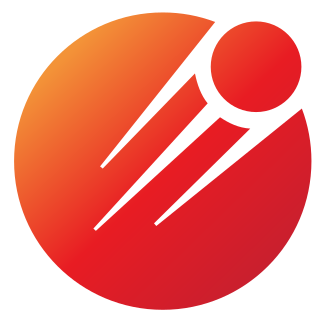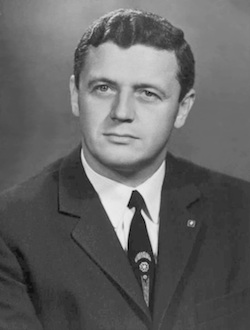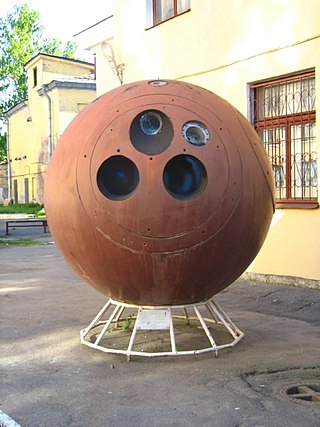
An astronaut is a person trained, equipped, and deployed by a human spaceflight program to serve as a commander or crew member aboard a spacecraft. Although generally reserved for professional space travelers, the term is sometimes applied to anyone who travels into space, including scientists, politicians, journalists, and tourists.

The Soyuz programme is a human spaceflight programme initiated by the Soviet Union in the early 1960s. The Soyuz spacecraft was originally part of a Moon landing project intended to put a Soviet cosmonaut on the Moon. It was the third Soviet human spaceflight programme after the Vostok (1961–1963) and Voskhod (1964–1965) programmes.

Vladimir Mikhaylovich Komarov was a Soviet test pilot, aerospace engineer, and cosmonaut. In October 1964, he commanded Voskhod 1, the first spaceflight to carry more than one crew member. He became the first Soviet cosmonaut to fly in space twice when he was selected as the solo pilot of Soyuz 1, its first crewed test flight. A parachute failure caused his Soyuz capsule to crash into the ground after re-entry on 24 April 1967, making him the first human to die in a space flight.

PAO S. P. Korolev Rocket and Space Corporation Energia, also known as RSC Energia, is a Russian manufacturer of spacecraft and space station components. The company is the prime developer and contractor of the Russian crewed spaceflight program; it also owns a majority of Sea Launch. Its name is derived from Sergei Korolev, the first chief of its design bureau, and the Russian word for energy.

Vostok 2 was a Soviet space mission which carried cosmonaut Gherman Titov into orbit for a full day on August 6, 1961, to study the effects of a more prolonged period of weightlessness on the human body. Titov orbited the Earth over 17 times, exceeding the single orbit of Yuri Gagarin on Vostok 1 − as well as the suborbital spaceflights of American astronauts Alan Shepard and Gus Grissom aboard their respective Mercury-Redstone 3 and 4 missions. Titov's number of orbits and flight time would not be surpassed by an American astronaut until Gordon Cooper's Mercury-Atlas 9 spaceflight in May 1963.

Vostok 6 was the first human spaceflight to carry a woman, cosmonaut Valentina Tereshkova, into space.

The Voskhod programme was the second Soviet human spaceflight project. Two one-day crewed missions were flown using the Voskhod spacecraft and rocket, one in 1964 and one in 1965, and two dogs flew on a 22-day mission in 1966.

Voskhod 1 was the seventh crewed Soviet space flight. Flown by cosmonauts Vladimir Komarov, Konstantin Feoktistov, and Boris Yegorov, it launched 12 October 1964, and returned on the 13th. Voskhod 1 was the first human spaceflight to carry more than one crewman into orbit, the first flight without the use of spacesuits, and the first to carry either an engineer or a physician into outer space. It also set a crewed spacecraft altitude record of 336 km (209 mi).

Vladislav Nikolayevich Volkov was a Soviet cosmonaut who flew on the Soyuz 7 and Soyuz 11 missions. The second mission terminated fatally. Volkov and the two other crew members were asphyxiated on reentry, the only three people to have died in outer space.
Human spaceflight programs have been conducted, started, or planned by multiple countries and companies. The age of crewed rocket flight was initiated by Fritz von Opel who piloted the world's first rocket-propelled flight on 30 September 1929. All space flights depend on rocket technology; von Opel was the co-designer and financier of the visionary project. Until the 21st century, human spaceflight programs were sponsored exclusively by governments, through either the military or civilian space agencies. With the launch of the privately funded SpaceShipOne in 2004, a new category of human spaceflight programs – commercial human spaceflight – arrived. By the end of 2022, three countries and one private company (SpaceX) had successfully launched humans to Earth orbit, and two private companies had launched humans on a suborbital trajectory.

Soyuz 12 was a September, 1973, crewed test flight by the Soviet Union of the newly redesigned Soyuz 7K-T spacecraft that was intended to provide greater crew safety in the wake of the Soyuz 11 tragedy. The flight marked the return of the Soviets to crewed space operations after the 1971 accident. The crew capacity of the capsule had been decreased from three to two cosmonauts to allow for pressure suits to be worn during launch, re-entry and docking. It was the first time pressure suits were used for reentry since the Voskhod 2 flight.

Zenit was a series of military photoreconnaissance satellites launched by the Soviet Union between 1961 and 1994. To conceal their nature, all flights were given the public Kosmos designation.
A mission patch is a cloth reproduction of a spaceflight mission emblem worn by astronauts and other personnel affiliated with that mission. It is usually executed as an embroidered patch. The term space patch is mostly applied to an emblem designed for a crewed space mission. Traditionally, the patch is worn on the space suit that astronauts and cosmonauts wear when launched into space. Mission patches have been adopted by the crew and personnel of many other space ventures, public and private.
Valentina Leonidovna Ponomaryova was a Soviet cosmonaut, pilot and scientist.

The R-7 family of rockets is a series of rockets, derived from the Soviet R-7 Semyorka, the world's first intercontinental ballistic missile (ICBM). More R-7 rockets have been launched than any other family of large rockets.
Kosmos 7, also known as Zenit-2 No.4 and occasionally in the West as Sputnik 17 was a Soviet reconnaissance satellite launched in 1962. It was the seventh satellite to be designated under the Kosmos system, and the second successful launch of a Soviet reconnaissance satellite.
Kosmos 9, also known as Zenit-2 No.7, was a Soviet reconnaissance satellite launched in 1962. It was the ninth satellite to be designated under the Kosmos system, and the third successful launch of a Soviet reconnaissance satellite, following Kosmos 4 and Kosmos 7.
Kosmos 10, also known as Zenit-2 No.5, was a Soviet reconnaissance satellite launched in 1962. It was the tenth satellite to be designated under the Kosmos system, and the fourth successful launch of a Soviet reconnaissance satellite, following Kosmos 4, Kosmos 7 and Kosmos 9.













